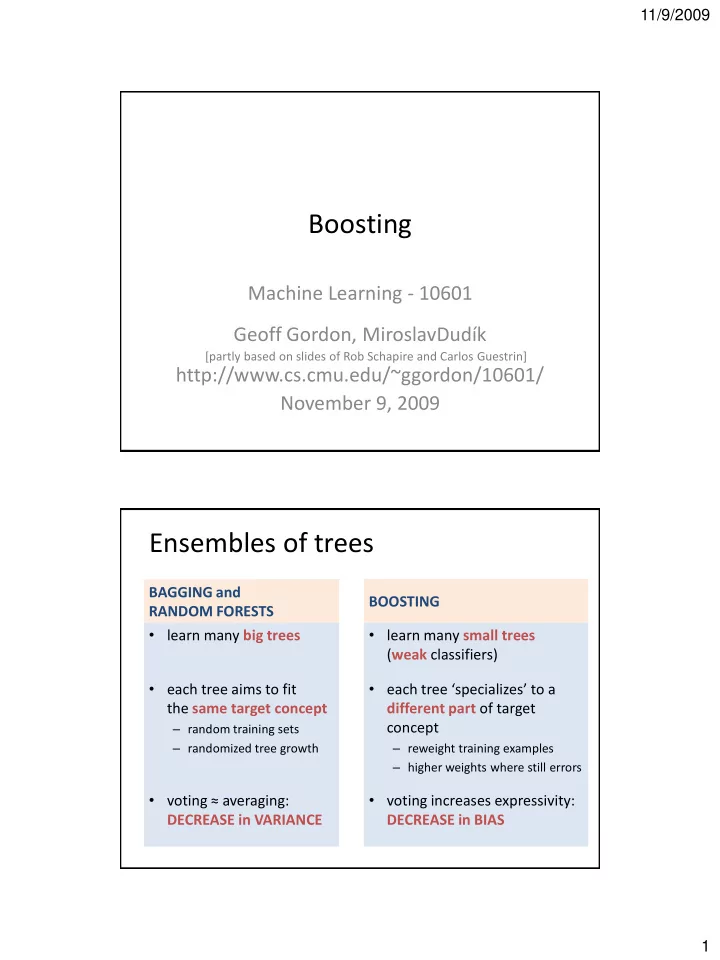

11/9/2009 Boosting Machine Learning - 10601 Geoff Gordon, MiroslavDudík ([[[partly based on slides of Rob Schapire and Carlos Guestrin] http://www.cs.cmu.edu/~ggordon/10601/ November 9, 2009 Ensembles of trees BAGGING and BOOSTING RANDOM FORESTS • learn many big trees • learn many small trees ( weak classifiers) • each tree aims to fit • each tree ‘specializes’ to a the same target concept different part of target – random training sets concept – randomized tree growth – reweight training examples – higher weights where still errors • voting ≈ averaging: • voting increases expressivity: DECREASE in VARIANCE DECREASE in BIAS 1
11/9/2009 Boosting • boosting = general method of converting rough rules of thumb (e.g., decision stumps) into highly accurate prediction rule Boosting • boosting = general method of converting rough rules of thumb (e.g., decision stumps) into highly accurate prediction rule • technically: – assume given “weak” learning algorithm that can consistently find classifiers ( “rules of thumb” ) at least slightly better than random, say, accuracy ≥ 55% (in two-class setting) – given sufficient data, a boosting algorithm can provably construct single classifier with very high accuracy , say, 99% 2
11/9/2009 AdaBoost [Freund-Schapire 1995] 3
11/9/2009 weak classifiers = decision stumps (vertical or horizontal half-planes) 4
11/9/2009 5
11/9/2009 A typical run of AdaBoost • training error rapidly drops (combining weak learners increases expressivity) • test error does not increase with number of trees T (robustness to overfitting) 6
11/9/2009 7
11/9/2009 Bounding true error [Freund-Schapire 1997] • T = number of rounds • d = VC dimension of weak learner • m = number of training examples 8
11/9/2009 Bounding true error (a first guess) A typical run contradicts a naïve bound 9
11/9/2009 Finer analysis: margins [Schapire et al. 1998] Empirical evidence: margin distribution 10
11/9/2009 Theoretical evidence: large margins simple classifiers Previously More technically… Bound depends on: • d = VC dimension of weak learner • m = number of training examples • entire distribution of training margins 11
11/9/2009 Practical advantages of AdaBoost Application: detecting faces [Viola-Jones 2001] 12
11/9/2009 Caveats “Hard” predictions can slow down learning! 13
11/9/2009 Confidence-rated Predictions [Schapire-Singer 1999] Confidence-rated Predictions 14
11/9/2009 Confidence-rated predictions help a lot! Loss in logistic regression 15
11/9/2009 Loss in AdaBoost Logistic regression vs AdaBoost 16
11/9/2009 Benefits of model-fitting view What you should know about boosting • weak classifiers strong classifiers – weak: slightly better than random on training data – strong: eventually zero error on training data • AdaBoost prevents overfitting by increasing margins • regimes when AdaBoost overfits – weak learner too strong: use small trees or stop early – data noisy: stop early • AdaBoost vs Logistic Regression – exponential loss vs log loss – single-coordinate updates vs full optimization 17
Recommend
More recommend